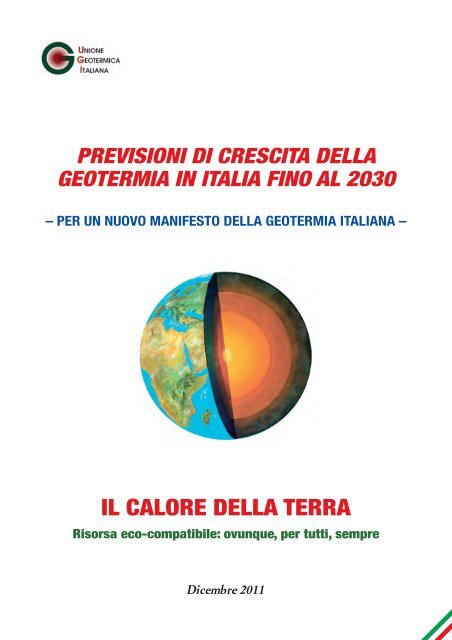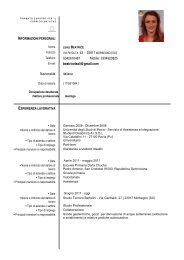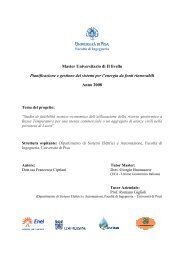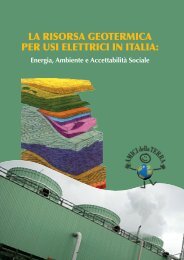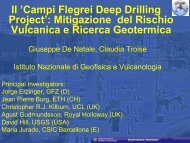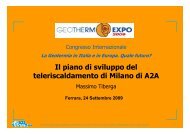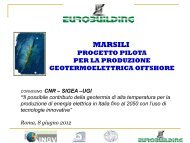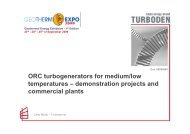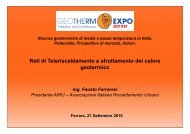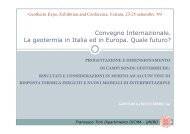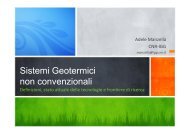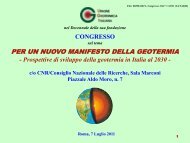Scarica la pubblicazione in formato PDF - Unione Geotermica Italiana
Scarica la pubblicazione in formato PDF - Unione Geotermica Italiana
Scarica la pubblicazione in formato PDF - Unione Geotermica Italiana
Create successful ePaper yourself
Turn your PDF publications into a flip-book with our unique Google optimized e-Paper software.
PREVISIONI DI CRESCITA DELLA<br />
GEOTERMIA IN ITALIA FINO AL 2030<br />
– PER UN NUOVO MANIFESTO DELLA GEOTERMIA ITALIANA –<br />
IL CALORE DELLA TERRA<br />
Risorsa eco-compatibile: ovunque, per tutti, sempre<br />
Dicembre 2011
GROWTH FORECAST OF GEOTHERMAL<br />
ENERGY IN ITALY BY 2030<br />
– FOR A NEW ITALIAN GEOTHERMAL MANIFESTO –<br />
THE EARTH’s HEAT<br />
Environmentally susta<strong>in</strong>able resource: everywhere, for all, always<br />
December 2011
I<br />
Riassunto espanso<br />
1. Il potenziale geotermico dell’Italia<br />
Le risorse geotermiche del territorio italiano a potenzialmente<br />
estraibili da profondità f<strong>in</strong>o a 5 km<br />
sono dell’ord<strong>in</strong>e di 21 exajoule (21x10 18 Joule, corrispondenti<br />
a circa 500 MTEP, ovvero 500 milioni<br />
di tonnel<strong>la</strong>te equivalenti di petrolio) b . Di esse,<br />
circa due terzi hanno temperatura <strong>in</strong>feriore a 150<br />
°C c . Pertanto, le risorse a temperatura così alta<br />
(T>80-90 °C) da permettere <strong>la</strong> produzione di energia<br />
elettrica a costi oggi competitivi con quelli di<br />
altre fonti di energia si trovano solo <strong>in</strong> poche aree<br />
del<strong>la</strong> fascia pre-appenn<strong>in</strong>ica tosco-<strong>la</strong>ziale-campana,<br />
delle due isole maggiori e di quelle vulcaniche del<br />
Tirreno, <strong>in</strong> corrispondenza di zone caratterizzate<br />
da forti anomalie del flusso di calore. Tali zone<br />
sono ubicate quasi esclusivamente nel settore occidentale<br />
del Paese (Fig. I).<br />
Al contrario, le risorse di media e bassa temperatura<br />
(T80-90°C), at costs currently competitive<br />
with those of other energy sources, exist<br />
only <strong>in</strong> areas with strong heat flow anomalies: the<br />
Tuscany-Latium-Campania pre-Apenn<strong>in</strong>e belt, the<br />
two ma<strong>in</strong> Italian is<strong>la</strong>nds, and some volcanic is<strong>la</strong>nds<br />
of the Tyrrhenian Sea, all located <strong>in</strong> western<br />
and south-western Italy (Fig. I).<br />
Conversely, medium- and low-temperature resources<br />
(T
II<br />
Fig. I: Flusso di calore conduttivo nel territorio italiano<br />
(Conductive heat flow <strong>in</strong> Italy)<br />
2. La geotermia nel quadro energetico nazionale<br />
al Dicembre 2010<br />
Il consumo totale di energia <strong>in</strong> Italia nel 2010 è sta -<br />
to di 185 MTEP, di cui l’83% da combustibili fossili<br />
(petrolio, gas, carbone), il 5% da elettricità<br />
im portata, ed il 12 % da fonti r<strong>in</strong>novabili e non<br />
convenzionali di energia (soprattutto idroelettrica,<br />
eolica, fotovoltaica, da biomassa e geotermica).<br />
La percentuale di queste ultime è passata dal 7%<br />
del 2005 al 12% del 2010, <strong>in</strong> parte a causa del dim<strong>in</strong>uito<br />
consumo totale di energia (da 198 MTEP<br />
del 2005 a 185 MTEP del 2010) ed <strong>in</strong> parte per<br />
l’impulso dato <strong>in</strong> questi ultimi anni al loro sviluppo.<br />
L’energia geotermica, <strong>in</strong> partico<strong>la</strong>re, è passata da<br />
1,19 MTEP del 2005 ad 1,32 MTEP del 2010, per<br />
cui il suo contributo ai consumi totali di energia è<br />
aumentato nel periodo <strong>in</strong> esame da 0,6 a 0,71%.<br />
2. Geothermal energy with<strong>in</strong> the national energy<br />
framework as of December 2010<br />
In 2010, total energy consumption <strong>in</strong> Italy amoun -<br />
ted to 185 MTOE: 83% from fossil fuels (oil, gas,<br />
coal); 5% from imported electricity; and 12% from<br />
renewable and non-conventional energy sources<br />
(mostly hydro, w<strong>in</strong>d, photovoltaic, biomass and<br />
geo thermal).<br />
The share of the <strong>la</strong>tter sources climbed from 7% <strong>in</strong><br />
2005 to 12% <strong>in</strong> 2010 ow<strong>in</strong>g to the contraction of<br />
total energy consumption (from 198 MTOE <strong>in</strong><br />
2005 to 185 MTOE <strong>in</strong> 2010) and to the impetus<br />
which has been given to their development <strong>in</strong> the<br />
past few years.<br />
In particu<strong>la</strong>r, geothermal energy grew from 1.19<br />
MTOE <strong>in</strong> 2005 to 1.32 MTOE <strong>in</strong> 2010. Therefore,<br />
<strong>in</strong> the period under review, its contribution to the<br />
country’s total energy consumption mounted from<br />
0.6 to 0.71%.
III<br />
L’aumento è dovuto soprattutto al maggior apporto<br />
degli usi diretti del calore, che sono passati<br />
da 0,2 MTEP del 2005 a 0,3 MTEP del 2010, con<br />
un <strong>in</strong>cremento medio annuo dell’8,5%. La produzione<br />
di energia geotermoelettrica, <strong>in</strong>vece, pur essendo<br />
stata prevalente rispetto agli usi diretti, è<br />
aumentata nello stesso periodo da 0,99 ad 1,02<br />
MTEP, con un tasso di <strong>in</strong>cremento medio di appena<br />
lo 0,6% all’anno.<br />
Si è verificata qu<strong>in</strong>di dal 2005 al 2010 una crescita<br />
complessiva del<strong>la</strong> geotermia molto modesta rispetto<br />
al grande potenziale di cui l’Italia dispone,<br />
soprattutto per usi diretti.<br />
3. Sviluppo del<strong>la</strong> geotermia f<strong>in</strong>o al 2030<br />
Premesso quanto sopra, per vedere quale ragionevole<br />
contributo il calore del<strong>la</strong> Terra può dare<br />
al<strong>la</strong> futura copertura dei fabbisogni nazionali di<br />
energia, e per <strong>la</strong>nciare qu<strong>in</strong>di un Nuovo Manifesto<br />
del<strong>la</strong> Geotermia <strong>Italiana</strong> con visione più ampia<br />
dell’altro simile “Manifesto” pubblicato dall’UGI<br />
quasi 5 anni fa, è stato impostato agli <strong>in</strong>izi del<br />
2011 e recentemente concluso lo studio <strong>in</strong> oggetto,<br />
con tappe temporizzate al 2012, 2015,<br />
2020, 2025 e 2030, <strong>in</strong> modo da poter fare periodici<br />
aggiornamenti.<br />
In base allora alle caratteristiche geologiche del territorio<br />
italiano ed al tipo di risorse geotermiche esistenti<br />
f<strong>in</strong>o a 5 km di profondità, considerando il<br />
probabile forte aumento dei prezzi dei combustibili<br />
fossili nei prossimi anni, e tenendo presenti i<br />
miglioramenti attesi dal<strong>la</strong> tecnologia di utilizzazione<br />
del calore terrestre, le stime di sviluppo sono<br />
state fatte, separatamente per <strong>la</strong> produzione di<br />
energia elettrica e per gli usi diretti, secondo i due<br />
seguenti diversi scenari di crescita:<br />
Scenario I: trend di sviluppo economico-sociale<br />
corrente, uso di tecnologie di produzione quasi soltanto<br />
mature, e prezzi al<strong>la</strong> fonte del greggio al 2030<br />
di 250 US $/barile (circa tre volte più alti, cioè, di<br />
quelli medi del 2010, che sono stati 80 US $/barile<br />
≈ 400-420 €/tonn);<br />
Scenario II: trend di sviluppo economico-sociale<br />
tra<strong>in</strong>ato da scelte politiche forti <strong>in</strong> senso ecologico,<br />
uso di tecnologie di produzione non solo mature<br />
ma anche avanzate, e prezzi al<strong>la</strong> fonte del greggio<br />
al 2030 di 300 US$/barile (circa quattro volte più<br />
alti, cioè, di quelli del 2010).<br />
The <strong>in</strong>crease is mostly owed to direct uses of natural<br />
heat, which passed from 0.2 MTOE <strong>in</strong> 2005 to 0.3<br />
MTOE <strong>in</strong> 2010: an average growth rate of 8.5%<br />
per year. In contrast, even though geothermal po -<br />
wer generation was dom<strong>in</strong>ant over direct uses, it<br />
ro se <strong>in</strong> the same period from 0.99 to 1.02 MTOE,<br />
i.e. at an average growth rate of as little as 0.6%<br />
per year.<br />
Consequently, from 2005 to 2010, geothermal deployment<br />
was rather poor as compared to Italy’s<br />
<strong>la</strong>rge geothermal potential, especially for direct<br />
uses.<br />
3. Italian geothermal development by 2030<br />
In early 2011, a study was <strong>in</strong>itiated to estimate the<br />
possible contribution of the Earth’s heat to the cove -<br />
ra ge of national energy requirements by 2030, with<br />
steps by 2012, 2015, 2020, 2025 to be periodically<br />
updated. The end goal of the study was to provide<br />
the Italian Government with factual elements on the<br />
possible medium-term deployment of this energy<br />
sour ce <strong>in</strong> Italy, as well as to <strong>la</strong>unch a New Ita lian<br />
Geothermal Manifesto with a wider vision than the<br />
one published by UGI almost five years ago.<br />
Growth projections were formu<strong>la</strong>ted by tak<strong>in</strong>g<br />
<strong>in</strong>to account: i) Italy’s geological sett<strong>in</strong>g and geo -<br />
thermal resources known or supposed to exist<br />
down to 5 km depth; ii) likely sharp <strong>in</strong>crease <strong>in</strong><br />
fossil fuel prices <strong>in</strong> the next years; and iii) expected<br />
technological improvements <strong>in</strong> the utilization<br />
of the Earth’s heat. Two different growth<br />
scenarios have thus been developed on the follow<strong>in</strong>g<br />
assumptions:<br />
Scenario I: current economic trend, use of mature<br />
production technologies, and prices of crude oil at<br />
source of 250 US $/bbl <strong>in</strong> 2030 (roughly three ti -<br />
mes higher than the average ones <strong>in</strong> 2010, i.e. 80<br />
US $/bbl, or € 400-420/tonne);<br />
Scenario II: economic trend driven by vigorous<br />
environmental policies, use of both mature and<br />
advanced production technologies, and prices of<br />
crude oil at source of 300 US $/bbl <strong>in</strong> 2030<br />
(roughly four times higher than <strong>in</strong> 2010).
IV<br />
Tab. A: Sviluppo dell’energia geotermoelettrica 2010-2030 con<br />
re<strong>la</strong>tivi risparmio di petrolio e riduzione di CO 2 emessa<br />
(2010-2030 development of geothermal power generation, with<br />
oil sav<strong>in</strong>gs and avoided CO 2 emissions)<br />
Anno/Year 2010 2020 2030<br />
SCENARIO I<br />
Potenza <strong>in</strong>stal<strong>la</strong>ta<br />
Installed capacity<br />
(MW e )<br />
882,5 1 080 1 500<br />
Produzione lorda (TWh/y)<br />
Gross generation<br />
5,343 6,9 9,4<br />
Olio risparmiato (kTOE/y)<br />
Oil saved<br />
1 020 1 310 1 790<br />
CO 2 evitata (kTonnes/y)<br />
Avoided CO 2 emissions<br />
3 200 4 140 5 700<br />
SCENARIO II<br />
Potenza <strong>in</strong>stal<strong>la</strong>ta<br />
Installed capacity<br />
(MWe)<br />
882,5 1 150 2 000<br />
Produzione lorda (TWh/y)<br />
Gross generation<br />
5,343 7,3 12,0<br />
Olio risparmiato (kTOE/y)<br />
Oil saved 1 020 1 390 2 280<br />
CO 2 evitata (kTonnes/y<br />
Avoided CO 2 emissions) 3 200 4 380 7 200<br />
Fig. II/A: Sviluppo del<strong>la</strong> produzione geotermoelettrica lorda<br />
2010-2030 secondo gli Scenari I e II<br />
(2010-2030 development of geothermal generation under Scenarios<br />
I and II)<br />
Tab. B: Sviluppo degli usi diretti 2010-2030 con re<strong>la</strong>tivi risparmio<br />
di petrolio e riduzione di CO 2 emessa<br />
(2010-2030 development of direct uses, with oil sav<strong>in</strong>gs and<br />
avoided CO 2 emissions)<br />
Anno/Year 2010 2020 2030<br />
SCENARIO I<br />
Potenza <strong>in</strong>stal<strong>la</strong>ta<br />
Installed capacity<br />
(MW th )<br />
1 000 2 510 7 400<br />
Produzione lorda<br />
Gross production<br />
(TJ/y)<br />
12 600 26 380 65 200<br />
Olio risparmiato (kTOE/y)<br />
Oil saved<br />
300 630 1 560<br />
CO 2 evitata (kTonnes/y)<br />
Avoided CO 2 emissions 800 1 640 4 060<br />
SCENARIO II<br />
Potenza <strong>in</strong>stal<strong>la</strong>ta<br />
Installed capacity<br />
(MW th ) 1 000 2 750 8 800<br />
Produzione lorda<br />
Gross production<br />
(TJ/y)<br />
12 600 30 660 90 000<br />
Olio risparmiato (kTOE/y)<br />
Oil saved 300 740 2 160<br />
CO 2 evitata (kTonne/y)<br />
Avoided CO 2 emissions 800 1 920 5 620<br />
Fig. II/B: Sviluppo degli usi diretti (pompe di calore <strong>in</strong>cluse) f<strong>in</strong>o<br />
al 2030 secondo gli Scenari I e II<br />
(2010-2030 development of direct uses <strong>in</strong>clud<strong>in</strong>g heat pumps under<br />
Scenarios I and II)
V<br />
Con queste ipotesi, partendo dallo stato al 2010, le<br />
stime di crescita al 2030 possono essere s<strong>in</strong>tetizzate<br />
come si vede <strong>in</strong> Tab. A e Fig. II/A per l’energia<br />
geotermoelettrica, ed <strong>in</strong> Tab. B e Fig. II/B per l’<strong>in</strong>sieme<br />
degli usi diretti. In questi ultimi è <strong>in</strong>clusa<br />
anche <strong>la</strong> quota parte di energia prodotta con l’impiego<br />
di pompe di calore geotermiche.<br />
On this basis, the 2010-2030 growth projections<br />
under Scenarios I and II are summarized <strong>in</strong> Tab. A<br />
and Fig. II/A for geothermal power generation and<br />
<strong>in</strong> Tab. B and Fig. II/B for direct uses.<br />
These uses <strong>in</strong>clude the energy produced with geo -<br />
thermal heat pumps.<br />
Sul<strong>la</strong> distribuzione regionale dell’energia prodotta<br />
si pensa che essa possa provenire f<strong>in</strong>o al 2015 soltanto<br />
dal<strong>la</strong> Toscana, con un progressivo sviluppo<br />
anche <strong>in</strong> altre Regioni d’Italia a partire dal<strong>la</strong> seconda<br />
metà di questo decennio.<br />
La quota parte di energia geotermoelettrica prodotta<br />
dalle altre Regioni può giungere nel 2030 al<br />
18% nel caso dello Scenario I, ed al 25% nel caso<br />
dello Scenario II.<br />
Per <strong>la</strong> frazione degli usi diretti alimentata da pom -<br />
pe di calore geotermiche, si stima una crescita pro -<br />
gres siva, rispetto al totale degli usi diretti stessi, dai<br />
1.700 TJ/a del 2010 a quasi 4.700 TJ/a nel 2020 ed<br />
a 15.000 TJ/a nel 2030 secondo lo Scenario II, passando<br />
così dall’attuale 13,5% a ~ 17% nel Dicembre<br />
2030.<br />
Per il contributo specifico dei differenti comparti<br />
degli usi diretti (climatizzazione di ambienti, termalismo,<br />
usi agricoli, itticoltura, processi <strong>in</strong>dustriali<br />
ed altri usi m<strong>in</strong>ori), si stima per tutti un<br />
importante <strong>in</strong>cremento <strong>in</strong> valore assoluto; ma <strong>la</strong> climatizzazione<br />
di ambienti, già al primo posto nel<br />
2010 con il 38%, diventerà via via più importante<br />
f<strong>in</strong>o a costituire nel 2030 oltre il 60% del totale.<br />
4. Benefici attesi dallo sviluppo del<strong>la</strong> geotermia<br />
f<strong>in</strong>o al 2030<br />
Tali benefici possono essere ricondotti a due<br />
gruppi pr<strong>in</strong>cipali: i) tecnici ed ambientali; ed ii)<br />
economico-sociali e scientifici.<br />
4.1) Benefici tecnici ed ambientali<br />
Dai valori esposti nelle Tabelle A e B per <strong>la</strong> produzione<br />
geotermo-elettrica e per gli usi diretti si<br />
ev<strong>in</strong>ce che i benefici ottenibili con l’uso di risorse<br />
geotermiche f<strong>in</strong>o al 2030 possono essere quantificati<br />
come segue.<br />
a) Risparmio di petrolio equivalente:<br />
– per lo Scenario I: 1,94 (1,31+0,63) MTEP nel<br />
2020, e 3,35 (1,79+1,56) MTEP nel 2030;<br />
– per lo Scenario II: 2,13 (1,39+0,74) MTEP nel<br />
2020, e 4,44 (2,28+2,16) MTEP nel 2030.<br />
In terms of regional distribution, geothermal<br />
power generation is estimated to come from Tuscany,<br />
but only until 2015; afterwards, beg<strong>in</strong>n<strong>in</strong>g<br />
<strong>in</strong> the second half of this decade, it is expected to<br />
start com<strong>in</strong>g also from other Italian Regions.<br />
The share of geothermal power generated <strong>in</strong><br />
the <strong>la</strong>tter Regions may atta<strong>in</strong> by 2030, 18% of<br />
the total under Scenario I, and 25% under Scenario<br />
II.<br />
Concern<strong>in</strong>g direct uses, the share obta<strong>in</strong>ed by<br />
geo thermal heat pumps is estimated to progressively<br />
rise from 1,700 TJ/yr <strong>in</strong> 2010 to nearly<br />
4,700 TJ/yr <strong>in</strong> 2020 and to 15,000 TJ/yr <strong>in</strong> 2030<br />
under Scenario II, thus from 13.5% at present to<br />
roughly 17% by December 2030.<br />
All types of direct uses (space heat<strong>in</strong>g and cool<strong>in</strong>g,<br />
balneotherapy, farm<strong>in</strong>g, fisheries, aquaculture, <strong>in</strong>dustrial<br />
processes and other m<strong>in</strong>or uses) are projected<br />
to <strong>in</strong>crease <strong>in</strong> absolute terms.<br />
However, space heat<strong>in</strong>g and cool<strong>in</strong>g, rank<strong>in</strong>g<br />
first <strong>in</strong> 2010 (38%), will grow faster than other<br />
uses, hitt<strong>in</strong>g over 60% of the total by 2030.<br />
4. Benefits expected from geothermal development<br />
until 2030<br />
These are of two ma<strong>in</strong> types: i) technical and<br />
environmental; and ii) economic-social and scientific.<br />
4.1) Technical and environmental benefits<br />
The values shown <strong>in</strong> Tables A and B for geothermal<br />
generation and direct uses quantify as follows<br />
the benefits result<strong>in</strong>g from the exploitation of geo -<br />
thermal resources until 2030.<br />
a) Sav<strong>in</strong>gs <strong>in</strong> terms of oil-equivalent:<br />
– for Scenario I: 1.94 (1.31+0.63) MTOE <strong>in</strong><br />
2020, and 3.35 (1.79+1.56) MTOE <strong>in</strong> 2030;<br />
– for Scenario II: 2.13 (1.39+0.74) MTOE <strong>in</strong><br />
2020 and 4.44 (2.28+2.16) MTOE <strong>in</strong> 2030.
VI<br />
Si nota così che il petrolio equivalente risparmiato<br />
con lo sviluppo degli usi diretti può giungere ad<br />
avere nel 2030, <strong>in</strong> entrambi gli Scenari, importanza<br />
economica quasi eguale a quel<strong>la</strong> dell’energia geotermoelettrica.<br />
Pertanto, a seconda del maggiore o<br />
m<strong>in</strong>ore contributo che i sistemi geotermici non con -<br />
venzionali potranno dare al<strong>la</strong> crescita dell’energia<br />
geotermoelettrica, è possibile che i ruoli di prevalenza<br />
tra queste due forme di utilizzazione del calore<br />
terrestre dopo il 2030 si <strong>in</strong>vertano.<br />
b) Riduzione di CO 2 emessa:<br />
– per lo Scenario I: 5,78 (4,14+1,64) MTonn nel<br />
2020, e 9,76 (5,7+4,06) MTonn nel 2030;<br />
– per lo Scenario II: 6,30 (4,38+1,92) MTonn nel<br />
2020, e 12,82 (7,2+5,62) MTonn nel 2030.<br />
c) Contributo al<strong>la</strong> copertura dei consumi totali di<br />
energia<br />
Partendo dai 185 MTEP <strong>in</strong>dicati per il 2010, ed<br />
ipotizzando che i consumi totali di energia primaria<br />
cont<strong>in</strong>u<strong>in</strong>o a dim<strong>in</strong>uire f<strong>in</strong>o al 2015, ma che torn<strong>in</strong>o<br />
poi a crescere negli anni successivi per<br />
giungere a ~ 200 MTEP nel 2020 ed a ~ 230<br />
MTEP nel 2030, si ricava che il contributo complessivo<br />
del<strong>la</strong> geotermia al risparmio di petrolio<br />
equivalente potrà aumentare dallo 0,71% del 2010<br />
all’1% circa nel 2020 per entrambi gli Scenari, per<br />
giungere poi nel 2030 all’1,5% nel caso dello Scenario<br />
I ed al 2% nel caso dello Scenario II.<br />
4.2) Benefici economico-sociali e scientifici<br />
Oltre a quelli tecnici ed ambientali sopra detti, si<br />
stima che lo sviluppo del<strong>la</strong> geotermia f<strong>in</strong>o al 2030<br />
possa dar luogo ai seguenti altri benefici.<br />
a) Nuovi posti di <strong>la</strong>voro fisso (<strong>la</strong>ureati, tecnici,<br />
operai), giungendo gradualmente a:<br />
– nel caso dello Scenario I: 50.000 persone/anno<br />
al 2020, e 100.000 persone/anno al 2030;<br />
– nel caso dello Scenario II: 100.000 per so ne/an no<br />
al 2020, e 200.000 persone/anno al 2030.<br />
b) Nuovi <strong>in</strong>vestimenti (spese di personale, pozzi<br />
di sviluppo, costruzione di macch<strong>in</strong>ari ed attrezzature,<br />
ed ogni altra spesa di sviluppo ad eccezione<br />
di quelle del punto seguente):<br />
– nel caso dello Scenario I: 300 M€ f<strong>in</strong>o al 2020,<br />
e 1.200 M€ f<strong>in</strong>o al 2030;<br />
– nel caso dello Scenario II: 500 M€ f<strong>in</strong>o al 2020,<br />
e 2.000 M€ f<strong>in</strong>o al 2030.<br />
These figures <strong>in</strong>dicate that, <strong>in</strong> 2030, the sav<strong>in</strong>gs<br />
<strong>in</strong> terms of oil-equivalent which can be achieved<br />
by direct uses are almost equal to those obta<strong>in</strong>ed<br />
by geothermal power generation. As a result, depend<strong>in</strong>g<br />
on the contribution that non-conventional<br />
geothermal systems may give after 2030 to the<br />
growth of geothermal generation, the energy weight<br />
and economic importance of direct uses is likely to<br />
prevail over the energy weight and economic importance<br />
of geothermal power generation.<br />
b) Avoided CO 2 emissions:<br />
– for Scenario I: 5.78 (4.14+1.64) Mtonnes <strong>in</strong><br />
2020 and 9.76 (5.7+4.06) Mtonnes <strong>in</strong> 2030;<br />
– for Scenario II: 6.30 (4.38+1.92) Mtonnes <strong>in</strong><br />
2020 and 12.82 (7.2+5.62) Mtonnes <strong>in</strong> 2030.<br />
c) Contribution to coverage of total energy consumption<br />
Total primary energy consumption (185 MTOE<br />
<strong>in</strong> 2010) is assumed to decrease until 2015 and to<br />
<strong>in</strong>crease aga<strong>in</strong> <strong>in</strong> the follow<strong>in</strong>g years, reach<strong>in</strong>g<br />
some 200 MTOE <strong>in</strong> 2020 and 230 MTOE <strong>in</strong><br />
2030.<br />
On this assumption, the overall contribution of<br />
geothermal energy to sav<strong>in</strong>gs <strong>in</strong> terms of oil-equivalent<br />
will rise from 0.71% <strong>in</strong> 2010 to about 1%<br />
under both Scenarios I and II <strong>in</strong> 2020, reach<strong>in</strong>g<br />
1.5% under Scenario I and 2% under Scenario II<br />
by 2030.<br />
4.2) Economic-social and scientific benefits<br />
In addition to the above-cited technical and environ -<br />
men tal benefits, geothermal development until 2030<br />
is expected to yield the follow<strong>in</strong>g other benefits.<br />
a) New permanent jobs (graduates, technicians,<br />
workers), gradually reach<strong>in</strong>g:<br />
– under Scenario I: 50,000 jobs/yr by 2020 and<br />
100,000 jobs/yr by 2030;<br />
– under Scenario II: 100,000 jobs/yr by 2020 and<br />
200,000 jobs/yr by 2030.<br />
b) New <strong>in</strong>vestments (personnel expenses, drill<strong>in</strong>g<br />
of any type, construction of mach<strong>in</strong>ery and equipment,<br />
and other development expenses, exclud<strong>in</strong>g<br />
those mentioned <strong>in</strong> the follow<strong>in</strong>g po<strong>in</strong>t):<br />
– under Scenario I: 300 M€ by 2020 and 1,200<br />
M€ by 2030;<br />
– under Scenario II: 500 M€ by 2020 and 2,000<br />
M€ by 2030.
VII<br />
c) Nuove attività di ricerca e sviluppo (<strong>in</strong> tutti i<br />
campi del<strong>la</strong> geotermia, e specialmente <strong>in</strong> quello<br />
del<strong>la</strong> ricerca e sperimentazione dei sistemi geotermici<br />
non convenzionali di alta temperatura per produzione<br />
di energia elettrica):<br />
– nel caso dello Scenario I: 100 M€ f<strong>in</strong>o al 2020,<br />
e 200 M€ f<strong>in</strong>o al 2030;<br />
– nel caso dello Scenario II: 200 M€ f<strong>in</strong>o al 2020,<br />
e 400 M€ f<strong>in</strong>o al 2030.<br />
In partico<strong>la</strong>re, allo scopo di effettuare una sperimentazione<br />
ampia delle tecnologie di utilizzazione<br />
dei sistemi geotermici non convenzionali nelle peculiari<br />
condizioni geologiche del territorio italiano, e<br />
per poter qu<strong>in</strong>di avviare entro 10-12 anni da ora il<br />
loro sviluppo per produrre energia geotermoelettrica<br />
a sca<strong>la</strong> commerciale, è necessario perforare<br />
f<strong>in</strong>o al 2020 da 10 a 20 pozzi di studio profondi 3÷5<br />
km, ubicati <strong>in</strong> siti geologicamente diversi tra loro.<br />
In alcuni di tali siti dovrebbero essere anche <strong>in</strong>stal<strong>la</strong>ti<br />
gruppi geotermoelettrici pilota di diverso tipo<br />
con cui effettuare prove di produzione prolungate.<br />
Solo così potrà essere assicurata una ragionevole<br />
replicabilità delle condizioni di sfruttamento del<br />
serbatoio e di esercizio degli impianti di generazione<br />
dei sistemi <strong>in</strong> paro<strong>la</strong>.<br />
5. Misure necessarie per raggiungere gli obiettivi<br />
<strong>in</strong>dicati<br />
Gli obiettivi <strong>in</strong>dicati dalle stime sono tecnicamente<br />
possibili. Esistono <strong>in</strong>fatti <strong>in</strong> Italia sia le risorse geologiche<br />
e le competenze professionali per farlo, che<br />
i vantaggi economici ed ambientali che li giusitificano;<br />
ma non possono essere raggiunti senza attivare<br />
i due seguenti, concatenati, gruppi di misure.<br />
5.1) Misure a livello nazionale ed istituzionale:<br />
– forte impegno del Governo, dei partiti politici e<br />
delle istituzioni per varare misure atte a favorire<br />
lo sviluppo delle fonti di energia r<strong>in</strong>novabile<br />
(FER) tra cui, <strong>in</strong> primo luogo, <strong>la</strong> geotermia;<br />
– Piano Energetico Nazionale (PEN) con previsioni<br />
di sviluppo f<strong>in</strong>o al 2030 di tutte le FER;<br />
– <strong>in</strong>centivi certi e prolungati per le FER che hanno<br />
il m<strong>in</strong>imo impatto ambientale;<br />
– legis<strong>la</strong>zione nazionale e l<strong>in</strong>ee guida specifiche per<br />
<strong>la</strong> formu<strong>la</strong>zione di norme di sviluppo del<strong>la</strong> geotermia<br />
secondo criteri omogenei tra le varie Regioni<br />
d’Italia;<br />
– programmi di R&S nel settore delle FER, con<br />
“progetti f<strong>in</strong>alizzati” per ciascuna di esse;<br />
c) New R&D (<strong>in</strong> all fields of geothermal energy,<br />
<strong>in</strong>clud<strong>in</strong>g but not limited to the implementation<br />
of a major R&D project focused on the development<br />
of non-conventional high-temperature systems<br />
for power generation):<br />
– under Scenario I: 100 M€ by 2020 and 200<br />
M€ by 2030;<br />
– under Scenario II: 200 M€ by 2020 and 400<br />
M€ by 2030.<br />
In particu<strong>la</strong>r, the above-said R&D project on nonconventional<br />
geothermal systems is aimed at test<strong>in</strong>g<br />
their characteristics <strong>in</strong> Italy’s peculiar geo logical<br />
sett<strong>in</strong>g and at mak<strong>in</strong>g it possible to start their systematic<br />
development for power generation 10-12<br />
years from now. Thus, <strong>in</strong> the current decade, 10<br />
to 20 <strong>in</strong>vestigation wells should be drilled down<br />
to 3÷5 km depth <strong>in</strong> geologically different sites.<br />
Pilot p<strong>la</strong>nts should also be <strong>in</strong>stalled <strong>in</strong> some of<br />
these sites <strong>in</strong> order to conduct long-term performance<br />
tests on the behavior of the geothermal reservoir<br />
under actual power generation conditions.<br />
This is the only way to ensure that non-conventional<br />
systems are harnessed under repeatable conditions<br />
of reservoir exploitation and power p<strong>la</strong>nt<br />
operation.<br />
5. Measures required to achiev<strong>in</strong>g the targets<br />
The targets <strong>in</strong>dicated by the projections are technically<br />
feasible because: i) Italy has all geological<br />
resources and specific professional skills needed to<br />
atta<strong>in</strong> them; and ii) they are justified both from<br />
the economic and environmental viewpo<strong>in</strong>ts.<br />
Nonetheless, their achievement requires the follow<strong>in</strong>g<br />
sets of <strong>in</strong>terre<strong>la</strong>ted measures.<br />
5.1)Measures at national and <strong>in</strong>stitutional level:<br />
– strong commitment by Government, political<br />
parties and <strong>in</strong>stitutions to enact<strong>in</strong>g legis<strong>la</strong>tion <strong>in</strong><br />
support of renewables (RES) and, <strong>in</strong> particu<strong>la</strong>r,<br />
of geothermal energy;<br />
– National Energy P<strong>la</strong>n (NEP) <strong>in</strong>clud<strong>in</strong>g goals of<br />
development of all RES until 2030;<br />
– secure and prolonged <strong>in</strong>centives for RES with no<br />
or m<strong>in</strong>imum environmental impact;<br />
– national legis<strong>la</strong>tion and specific guidel<strong>in</strong>es<br />
aimed at harmoniz<strong>in</strong>g regional regu<strong>la</strong>tions on<br />
geothermal development;<br />
– R&D programs with project objectives targeted<br />
at each RES;
VIII<br />
– per <strong>la</strong> geotermia, <strong>in</strong> partico<strong>la</strong>re, è necessario realizzare<br />
entro il 2020 un progetto f<strong>in</strong>alizzato speciale<br />
per lo sviluppo dei sistemi geotermici non<br />
convenzionali;<br />
– campagne sistematiche di <strong>in</strong>formazione pubblica<br />
per illustrare i vantaggi economici ed ambientali<br />
derivanti dall’utilizzazione del calore del<strong>la</strong> Terra.<br />
5.2) Misure a livello regionale e locale:<br />
– Piano di <strong>in</strong>dirizzo energetico <strong>in</strong> tutte le Regioni<br />
d’Italia, con quantificazione degli obiettivi per ciascuna<br />
delle FER. Per <strong>la</strong> geotermia, <strong>in</strong> partico<strong>la</strong>re,<br />
ogni Piano dovrebbe poter contare su normative<br />
specifiche riguardanti lo sviluppo degli usi diretti;<br />
– censimento su base regionale dei pr<strong>in</strong>cipali poli<br />
di consumo di energia per valutare <strong>la</strong> domanda<br />
di calore e quantificare <strong>la</strong> quota attesa dallo sviluppo<br />
del<strong>la</strong> geotermia;<br />
– studi comparati di mercato del<strong>la</strong> domanda di calore<br />
a bassa temperatura;<br />
– quantificazione del<strong>la</strong> CO 2 emessa dalle diverse<br />
fonti di energia per il riscaldamento degli ambienti;<br />
– modifica dei vecchi impianti di riscaldamento <strong>in</strong><br />
almeno metà degli edifici pubblici e loro sostituzione<br />
con impianti alimentati da FER, con priorità<br />
per quelli alimentati da calore terrestre;<br />
– <strong>in</strong>centivi per l’<strong>in</strong>stal<strong>la</strong>zione di impianti di climatizzazione<br />
geotermici nei nuovi grandi edifici;<br />
– formazione di progettisti, <strong>in</strong>stal<strong>la</strong>tori e manutentori<br />
di impianti di climatizzazione con pompe di<br />
calore geotermiche;<br />
– campagne <strong>in</strong>formative nelle scuole sul<strong>la</strong> natura<br />
ed i vantaggi dell’uso del calore geotermico.<br />
– a special R&D project focused on “non-conventional<br />
geothermal systems”, to be implemented<br />
with<strong>in</strong> 2020;<br />
– systematic campaigns to build awareness among<br />
the public at <strong>la</strong>rge of the economic and environmental<br />
advantages of the Earth’s heat.<br />
5.2) Measures at regional and local level:<br />
– Regional energy p<strong>la</strong>ns for all Italian Regions,<br />
with quantitative targets for each RES, <strong>in</strong>clud<strong>in</strong>g<br />
geothermal. For the <strong>la</strong>tter, <strong>in</strong> particu<strong>la</strong>r, each<br />
p<strong>la</strong>n should rely on regu<strong>la</strong>tions specifically tailored<br />
to the development of direct uses;<br />
– regional surveys of energy-<strong>in</strong>tensive areas <strong>in</strong><br />
order to assess heat demand and quantify the expected<br />
share from geothermal development;<br />
– comparative market studies on demand for lowtemperature<br />
heat;<br />
– quantification of CO 2 emissions from the different<br />
sources of energy used for space heat<strong>in</strong>g;<br />
– rep<strong>la</strong>cement of old heat<strong>in</strong>g systems <strong>in</strong> at least<br />
half of public build<strong>in</strong>gs with systems us<strong>in</strong>g RES.<br />
Priority should be given to the use of natural<br />
heat;<br />
– f<strong>in</strong>ancial <strong>in</strong>centives for <strong>in</strong>stal<strong>la</strong>tion of geothermal<br />
heat<strong>in</strong>g & cool<strong>in</strong>g systems <strong>in</strong> new <strong>la</strong>rge<br />
build<strong>in</strong>gs;<br />
– tra<strong>in</strong><strong>in</strong>g of geothermal heat pump designers, <strong>in</strong>stallers<br />
and ma<strong>in</strong>tenance operators;<br />
– campaigns <strong>in</strong> schools to raise awareness of the<br />
Earth’s heat and its advantages.
MAIN APPLICATIONS OF GEOTHERMAL ENERGY<br />
STRONG DEVELOPMENT OF GEOTHERMAL ENERGy IN ITALy IS IMPERATIVE AND URGENT TO:<br />
• M<strong>in</strong>imize dependence on imported fuels<br />
• Curb the ba<strong>la</strong>nce-of-payments deficit<br />
• Mitigate the environmental impact of greenhouse gases<br />
• Contribute to the country’s susta<strong>in</strong>able development
LE PRINCIPALI APPLICAZIONI DELLA GEOTERMIA<br />
UN ACCELERATO SVILUPPO DELLA GEOTERMIA IN ITALIA È NECESSARIO ED URGENTE PER<br />
• Limitare <strong>la</strong> dipendenza dal petrolio<br />
• Ridurre il deficit del<strong>la</strong> bi<strong>la</strong>ncia dei pagamenti<br />
• Dim<strong>in</strong>uire l’impatto sull’ambiente dei gas ad effetto serra<br />
• Contribuire allo sviluppo sostenibile del Paese


